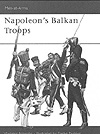Osprey Men-At-Arms 403:
Napoleonís Balkan Troops
Under Review
by Dave Hollins
| |
The fighting prowess of the Balkan peoples has only really come to the attention of the wider world in the tragic events of the 1990s as the old Yugoslavia broke up. Military enthusiasts for our period will know the Austrian Grenzers, the Frontier soldiers protecting the southern flank of the Austrian Empire, but few will be familiar with the short period of French rule of the Adriatic provinces running down through Croatian Dalmatia as far as the Ionian Islands. The rather unusual shape of modern Croatia is partly a creation of Napoleon Bonaparte, who in 1797 signed the Peace of Campo Formio, which allocated the former Venetian territories around the Adriatic Sea to Austria. Under the Peace of Pressburg (1805), these same territories were made part of the Kingdom of Italy and following the 1809 war, the western Military Frontier and some civilian areas were added to them to create the new Kingdom of Illyria, governed initially by Marshal Marmont. The area would return to Austrian control in 1813, although a covert struggle for control of Ragusa (Dubrovnik) and Cattaro would continue between Austria, Britain and Russia until the Congress of Vienna. Further south, France had taken the formerly Venetian Ionian Islands in 1797 and they were regularly contested with Russia, Britain and Turkey throughout the period. Initially, they formed the Septinsular Republic until incorporated into Illyria in 1809. This area was obviously of key strategic importance to all the major powers, but has received scant attention in print until now. Brnadic manages to take the reader through the geography and history of the area in just a couple of pages before covering the various units roughly in the order in which they were established before running through the assortment of former Ottoman troops in the oriental Chasseurs and the Franco-Italian units assigned to the local garrisons. It is certainly a heady mix Ė the overwhelming need was for infantry, but there were also a Hussar regiment, some Pioneers and the Seressaner Scouts. The infantry were newly-raised in the old Venetian areas, who wore French uniforms, but were augmented by some pretty rough looking irregulars in local costumes we would normally associate with the 18th century irregulars and traditional Greek clothes. After 1809, the six Grenz regiments were so useful that Napoleon retained their old recruitment system, while a shortage of money meant that the old uniforms were either adjusted with French emblems or dyed with perhaps unintended results. The civilian areas ceded to France also recruited a separate Illyrian Regiment, many of them former Austrian line infantry. It was probably only the regiments, which went to Russia, who actually wore their proper uniforms Ė the Albanian and other Ionian troops seem to have been left to their own devices. Inevitably with the more obscure subjects, illustrations can be a real headache for any author, but Brnadic has been able to locate several rare contemporary pictures, alongside collections of old Balkan weapons and (quite miraculously) even a picture of a fannion from the Army Museum in Vienna. These are mixed with pictures of local peoples, illustrating the clothes probably worn by the irregular units, and later reconstructions to present the entire range of what was being worn in this period. The author also manages to fit a useful outline of the service histories of each unit with their uniforms and equipment, so this is a comprehensive reference. Darko Pavolovicís plates are up to his usual high standard and in exceptional detail, cover the full range of uniforms from the official French styles through the recycled old Austrian uniforms to the local styles worn by Albanian troops. They would certainly make a colourful addition to any French wargames army Ė and the eleven battalions (8,000 troops), which went to Russia in 1812 are now properly recognised. I should add that, being interested in the troops from this part of Europe, I know both the author and artist, but my only involvement in this book was in tidying up the language style Ė as these guys are on their home turf! A useful reference work for anyone interested in Napoleonís armies. Recommended. Under Reviews Book Reviews
Nelsonís Fleet at Trafalgar Artillery of the Napoleonic Wars Back to Table of Contents -- First Empire # 78 Back to First Empire List of Issues Back to MagWeb Master Magazine List © Copyright 2004 by First Empire. This article appears in MagWeb.com (Magazine Web) on the Internet World Wide Web. Other articles from military history and related magazines are available at http://www.magweb.com |
 by Vladimir Brnadic and illustrated by Darko Pavlovic
by Vladimir Brnadic and illustrated by Darko Pavlovic